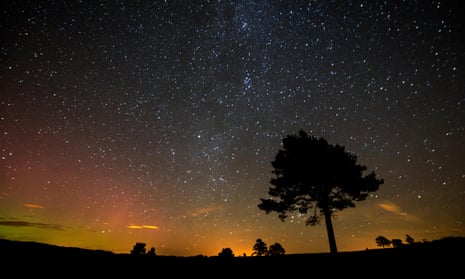The night sky is peppered with light from stars, planets and other celestial bodies. But now researchers have revealed one of the brightest objects visible from Earth is a communications satellite resembling a Tetris block.
Scientists say while the apparent brightness of BlueWalker 3 is not constant, its peak is on a par with Procyon and Achernar, two of the brightest stars in the night sky.
“After BlueWalker 3 unfolded its 64m2 array it is visible in both dark sky and urban skies, though in urban settings, this will be limited to when Bluewalker 3 passes overhead,” said Dr Jeremy Tregloan-Reed, a co-author of the study at the Universidad de Atacama in Chile.
But the appearance of the satellite is more than a mere curiosity.
“Large constellations of bright artificial satellites in low Earth orbit (LEO) pose significant challenges to ground-based astronomy,” the study’s authors write.
Tregloan-Reed says, among other problems, a large reflective brightness means when a satellite crosses the detector of a telescope, it leaves a streak that can be difficult, if not impossible, to remove so data in the affected pixels can be recovered.
But he added space-based astronomy also faced challenges from such satellites, noting observations by the Hubble telescope had increasingly been affected by Starlink streaks because the telescope was in a LEO, sitting below that of the satellite internet constellation.
While the researchers say efforts are being made by the aerospace industry, policymakers, astronomers and others to mitigate the impact of such satellites, “the trend towards the launch of increasingly larger and brighter satellites continues to grow”.
BlueWalker 3, built by AST SpaceMobile, is only a predecessor to a planned constellation of satellites nicknamed BlueBirds.
A spokesperson at AST SpaceMobile said by building their space-based cellular broadband network they aim to alleviate poverty, spur economic development and save lives, adding that their constellation is expected to involved around 90 satellites, far fewer than some others.
They also stressed the company is working to address the concerns of astronomers, including by planning to equip their next-generation satellites with anti-reflective materials and avoiding broadcasts within or adjacent to the US National Radio Quiet Zone.
However the researchers note that there is another concern: the radio frequencies used by BlueWalker 3 are close to those used for radio astronomy, raising the possibility such satellites could cause interference, making it harder for scientists to study the universe.
Writing in the journal Nature, researchers describe how a team of amateur and professional astronomers from Chile, the US, Mexico, New Zealand, the Netherlands and Morocco joined forces to make observations of the night sky, and explore the impact of BlueWalker 3 – the largest commercial communications array in LEO.
While BlueWalker 3 was folded when it was launched in September last year, once in space the array opened to reveal a huge surface area that reflected sunlight.
However, Tregloan-Reed noted another important factor in how bright an object appears was its distance from Earth, with satellites such as BlueWalker 3 in LEO appearing much brighter than geostationary satellites.
Tregloan-Reed added that even if all the reflective brightness of all satellites was reduced to below the level visible by the naked eye, there could be problems. “The sky background glow will increase due to the cumulative effect of having hundreds of thousands of satellites from various operators from many countries in low Earth orbit,” he said.
The study is not the first to raise concerns over increasing brightness in the night sky as a result of such artificial objects.
This year researchers called for scientists to stand up to “big light”, saying the number of low-altitude satellites should be capped to reduce light pollution and preserve the ability to study the night sky.
